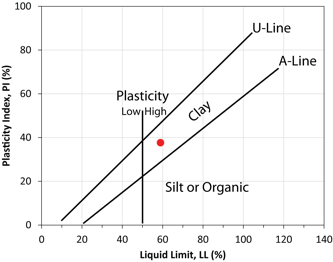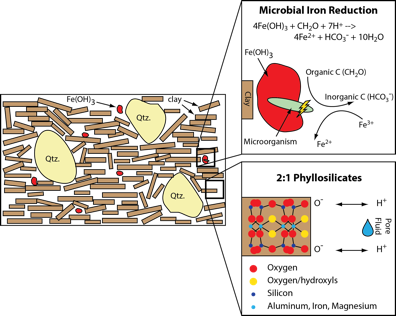Reports: DNI855617-DNI8: Effects of Microbial Activity on Mechanical and Transport Properties of Mudstones
Julia S. Reece, PhD, Texas A&M University
Marine mudstones can act as seals for hydrocarbons or even become unconventional reservoirs themselves. Microorganisms that comprise many of these marine mudstones play an important role in early diagenesis and, thus, have a subsequent influence on reservoir development. In order to better understand the effects of microbial activity on mechanical and transport properties of mudstones, we will develop a detailed experimental program in which we will measure the changes in microstructure, permeability, porosity, compressibility, pore fluid chemistry, and microbiology due to the presence of bacteria during deposition and burial of mudstones.
Project year 2 involved characterizing samples, testing out resedimentation experiments, and working on a chemical model for microbial iron reduction that also accounts for the buffering capacity of clay-rich sediments. Doctoral student N. Tanner Mills continued as the main student on this project. Melanie Bowen is an undergraduate student who has helped with the experimental setup, the characterization of the samples, and the preparation of the samples for resedimentation experiments. Associate Professor Michael Tice has been involved through discussions with graduate student Tanner on the chemical model and associated experimentation to test the model.
During Project year 1 PhD student Tanner and PI Reece gathered mudstones through the International Ocean Discovery Program (IODP) from two different sites in the Gulf of Mexico and started to characterize the material. In year 2, Tanner continued the characterization. He measured grain size distributions of both sets of mudstones with a laser particle size analyzer (Fig. 1) and the hydrometer technique (Fig. 2). For the mudstone from Site U1324, which is the site we will be focusing on first, Tanner also measured Atterberg Limits using the Casagrande cup and hand roll method (Fig. 3) and bulk mineralogy using X-ray powder diffraction (Fig. 4). The grain size distributions of both mudstone samples are very similar. They have about 58% of clay-size particles (< 2 mm). The liquid and plastic limits of mudstone from U1324 are 60% and 21%, respectively, which results in a plasticity index of 39% making it a highly plastic clay-rich mudstone. The mudstone from U1324 contains quartz, muscovite, albite, total amorphous minerals, dolomite, calcite, and kaolinite. Further work will be completed in the near future to confirm this measurement and perform a detailed clay mineralogy analysis in order to distinguish between muscovite and other clay minerals.
In addition to the characterization efforts, we have continued to test our resedimentation setups with materials other than our limited amount of Gulf of Mexico mudstones. Therefore, we have not yet run a resedimentation experiment on the material collected for this project.
Figure 1: Cumulative grain size distributions for bulk mudstones from Sites U1319 and U1324 measured with the laser particle size analyzer.
Figure 2: Grain size distributions for bulk mudstones from U1324 (two repeatable trials) measured with the hydrometer technique. Both mudstones are composed of 58% clay-size particles (< 2mm).
Figure 3: Plasticity chart for mudstones from Site U1324 showing that the material is a high plasticity clay.
Figure 4: Quantitative pie chart showing the distribution of minerals in the mudstones from Site U1324 measured with X-ray powder diffraction.
A significant amount of time on this project went into developing a chemical model for microbial iron reduction that also accounts for the buffering capacity of clay-rich sediments. This process needed to be understood first before we actually mixed the iron reducing bacteria Shewanella oneidensis MR-1 with the mudstone together and tested their hydromechanical and microstructural behavior.
The edge sites of clay minerals house negatively charged oxygen atoms that can interact with protons when in solution, depending on solution pH. These acid-base properties of clay minerals have previously been ignored in the study of mudstone diagenesis, even though clay minerals comprise a significant proportion of mudstone mineralogy. Given our large amount of clay minerals in the Gulf of Mexico mudstones we need to account for this process. Therefore, we have developed a chemical model for microbial iron reduction (Eq. 1) in mudstones that also accounts for the acid base properties of clay minerals.
This model is used to predict pore fluid pH and carbonate saturation. Once the model along with its experimental proof is complete, Tanner will start the resedimentation experiments, first the control experiment without any bacteria followed by the mudstone inoculated with bacteria.
Figure 5: Conceptual chemical model that accounts for microbial iron reduction as well as buffering capacity of clay-rich sediments.
The ACS PRF grant has facilitated career development for the PI, graduate student, and also undergraduate student involved in the project. This work is a significant extension of the experience of the PI Reece in resedimentation and geomechanical behavior of mudstones. At the same time it is an opportunity to explore new interrelationships between geomechanics and microbiology on various scales. This grant enabled graduate student Tanner Mills to pursue a challenging independent research project while simultaneously completing coursework designed to aid in his research project and prepare him for a career in industry or academia. He has gained valuable experience with the design and execution of difficult laboratory experiments that combine protocols from two different disciplines. Tanner has already connected with oil companies and will likely be able to complete an internship at some point during his PhD studies. He is also developing his communication skill set with a poster presentation of his research at the American Geophysical Union (AGU) Fall Meeting in December 2016, and at the upcoming Geological Society of America (GSA) Annual Meeting in October 2017. An additional benefit of this project is the involvement of an undergraduate geology student who helped purchase materials, setup equipment, prepared sediment samples, and helped analyze materials. This provided essential support in the laboratory and also provided a hands-on opportunity for the geology student at the undergraduate level to see what it takes to work in a laboratory and how graduate-level research is conducted.
















